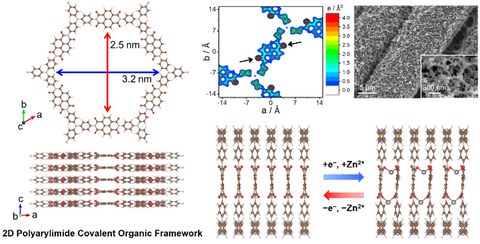Nov 20, 2020
Zn-ion energy storage device: a new application for 2D polyarylimide covalent organic frameworks
Zn-ion batteries, utilizing cheap, safe, and high ion-conductive (up to 1 S cm−1) water-based electrolytes, can effectively circumvent the safety and cost issues encountered by non-aqueous Li-ion batteries. The high power density (~5 kW kg−1) and decent energy density (~300 Wh kg−1, in theory) empower Zn-ion batteries to be robust alternatives for grid-scale energy storage devices. However, conventional Zn metal anodes suffer from several intrinsic drawbacks like dendrite growth, side reactions, and use in excess, giving rise to the battery stability concern. Therefore, searching for new anode materials is highly desired to construct reliable Zn-ion energy storage devices.
Recently, researchers from Technische Universität Dresden (Chair of Molecular Functional Materials) demonstrated the first Zn2+-storage anode based on a two-dimensional polyarylimide covalent organic framework (PI-COF) with a high-rate and long-life electrochemical behavior. The electrode is constructed by synthesizing imide-linked PI-COF on carbon nanotubes (CNTs) grown on carbon cloth via a condensation reaction between 1,4,5,8-naphthalene tetracarboxylic dianhydride (NTCDA) and tris (4-aminophenyl) amine (TAPA). Impressively, the obtained PI-COF exhibits a pseudocapacitive Zn2+-storage behavior with a specific capacity of 332 C g−1 (92 mAh g−1) at 0.7 A g−1, a large rate capability (79.8% at 7 A g−1) and a stable cycle life of 85% capacity retention over 4000 cycles. Through in-situ Raman spectroelectrochemistry and DFT calculations, the work also highlights the Zn2+-storage mechanism of the PI-COF electrode to be a two-step redox reaction, which involves the reversible formation of enolates by the stepwise coordination of carbonyl O with Zn2+. Such a favorable anode further enables the assembly of a flexible, high-rate, and dendrite-free full Zn-ion energy storage device. These encouraging results will inspire more efforts devoted to designing new redox-active monomers and fabricating polyarylimide COF structures with higher theoretical specific capacity.
This work was financially supported by European Union’s Horizon 2020 research and innovation programme (GrapheneCore3 881603), ERC Consolidator grant (T2DCP 819698), Deutsche Forschungsgemeinschaft (MX‐OSMOPED), M-ERA.NET and Sächsisches Staatsministerium für Wissenschaft und Kunst (HYSUCAP 100478697), and German Research Foundation (DFG) within the Cluster of Excellence, CRC 1415 (grant no. 417590517), and Polymer-based Batteries (SPP 2248, RACOF-MMIS). The authors acknowledge the use of the facilities in Dresden Center for Nanoanalysis at Technische Universität Dresden. The authors gratefully acknowledge Paderborn Center for Parallel Computing (PC2) and Gauss Centre for Supercomputing e.V. for funding this project by providing computing time on the FPGA-based supercomputer Noctua and the GCS Supercomputer JUWELS at Jülich Supercomputing Centre (JSC).
Reference:
Minghao Yu, Naisa Chandrasekhar, Ramya Kormath Madam Raghupathy, Khoa Hoang Ly, Haozhe Zhang, Evgenia Dmitrieva, Chaolun Liang, Xihong Lu, Thomas D. Kühne, Hossein Mirhosseini, Inez M. Weidinger, Xinliang Feng*, A High-Rate Two-Dimensional Polyarylimide Covalent Organic Framework Anode for Aqueous Zn-Ion Energy Storage Devices, J. Am. Chem. Soc.,2020.

